Overview
The article titled "10 Key Items on the DSM 5 Autism Checklist for Parents" highlights the vital components that parents should keep in mind when utilizing the DSM-5 checklist to evaluate autism in their children. Understanding these key items is not just important; it is essential for early identification and intervention. This proactive approach can significantly enhance outcomes for children with autism by enabling them to receive the tailored support and resources they need. Parents, your awareness and understanding can make all the difference in your child's journey.
Introduction
In the intricate landscape of autism support, understanding and addressing the unique needs of individuals on the spectrum is paramount. The rise of organizations like ASD Media has opened doors for families and professionals alike, providing invaluable resources that enhance the implementation of Applied Behavior Analysis (ABA) therapy. As the prevalence of autism continues to grow, the need for early diagnosis and tailored interventions becomes increasingly critical, significantly improving outcomes for children.
This article delves into the essential components of autism assessment, starting from the DSM-5 diagnostic criteria and emphasizing the importance of recognizing early signs and severity levels. By exploring the latest advancements in diagnostic tools and the critical role of ongoing assessments, we can uncover how a collaborative approach fosters a supportive environment for individuals with autism. Together, we can pave the way for a brighter future.
About ASD Media: Comprehensive Resources for Autism Support
At ASD Media, we are deeply committed to advancing the implementation of Applied Behavior Analysis (ABA) therapy. Our goal is to provide valuable insights and strategies that not only address common challenges but also improve outcomes for children with developmental disorders and ADHD. We offer a diverse range of resources tailored for both parents and professionals, empowering them to unlock the full potential of these children.
It's important to note that boys are diagnosed with developmental disorders 3.4 times more frequently than girls as of 2025, highlighting the urgent need for focused assistance. By fostering a nurturing community, ASD Media encourages the exchange of experiences and knowledge, which significantly enhances the effectiveness of support services for individuals facing these challenges.
Recent statistics reveal that 36.5% of caregivers for individuals with developmental disorders utilize ABA therapy, with many sharing positive outcomes. This underscores the vital role that community assistance plays in achieving successful therapy results. Furthermore, while 73.6% of autistic students graduate high school, a tailored approach, such as Individualized Education Programs (IEPs), is essential for those navigating educational hurdles.
Our Board-Certified Behavior Analysts (BCBAs) at Prospera Healthcare are dedicated to helping families understand developmental disorders and explore effective treatment options. ASD Media's mission is to cultivate collaboration and growth within the ABA therapy community, ensuring families have access to the resources they need for effective support.
Moreover, ABA therapy has been shown to bring measurable improvements in the daily lives of children with developmental conditions, reinforcing its significance and effectiveness. We invite you to join us in this journey of support and understanding, sharing your experiences and insights as we work together to create a brighter future for all children.
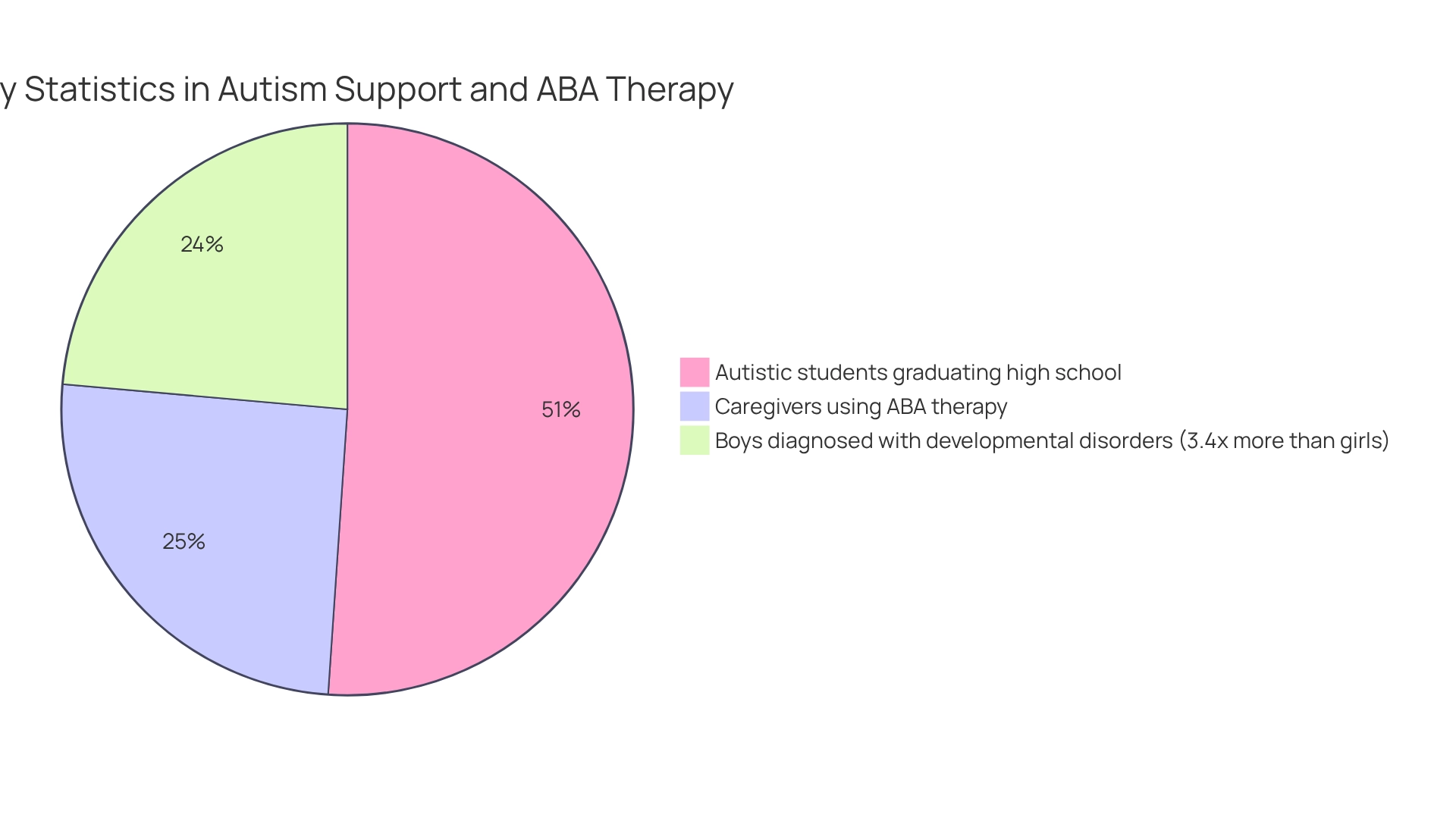
DSM-5 Diagnostic Criteria: Key Elements for Autism Assessment
The diagnostic criteria for Autism Spectrum Disorder (ASD) in the DSM-5 autism checklist outline the persistent challenges in social communication and interaction that many children face, as well as restricted and repetitive behaviors. These criteria are crucial for clinicians, helping ensure accurate diagnoses and allowing for tailored interventions that meet each child's unique needs.
Recent statistics reveal that early diagnosis and intervention can significantly lower healthcare costs, potentially reducing them by up to two-thirds. This underscores the critical importance of timely assessments. Clinicians widely regard the DSM-5 autism checklist as an invaluable tool for evaluating developmental disorders, as it provides a structured framework that enhances diagnostic accuracy and consistency.
Looking ahead to 2025, revisions to the DSM-5 autism checklist criteria continue to reflect our growing understanding of developmental disorders, ensuring that evaluations remain relevant and effective. These updates refine diagnostic language and criteria, allowing for a better understanding of the diverse ways ASD can manifest. Comprehensive evaluations, which consider developmental history, behavioral observations, and caregiver input, are key elements of the assessment process, incorporating the DSM-5 autism checklist to enhance accuracy in understanding each child's individual profile.
Furthermore, case studies highlight the societal shift towards greater acceptance of neurodevelopmental differences, creating a supportive environment for individuals with neurodiversity. This increasing awareness is essential for promoting inclusion and enhancing the quality of life for those on the spectrum.
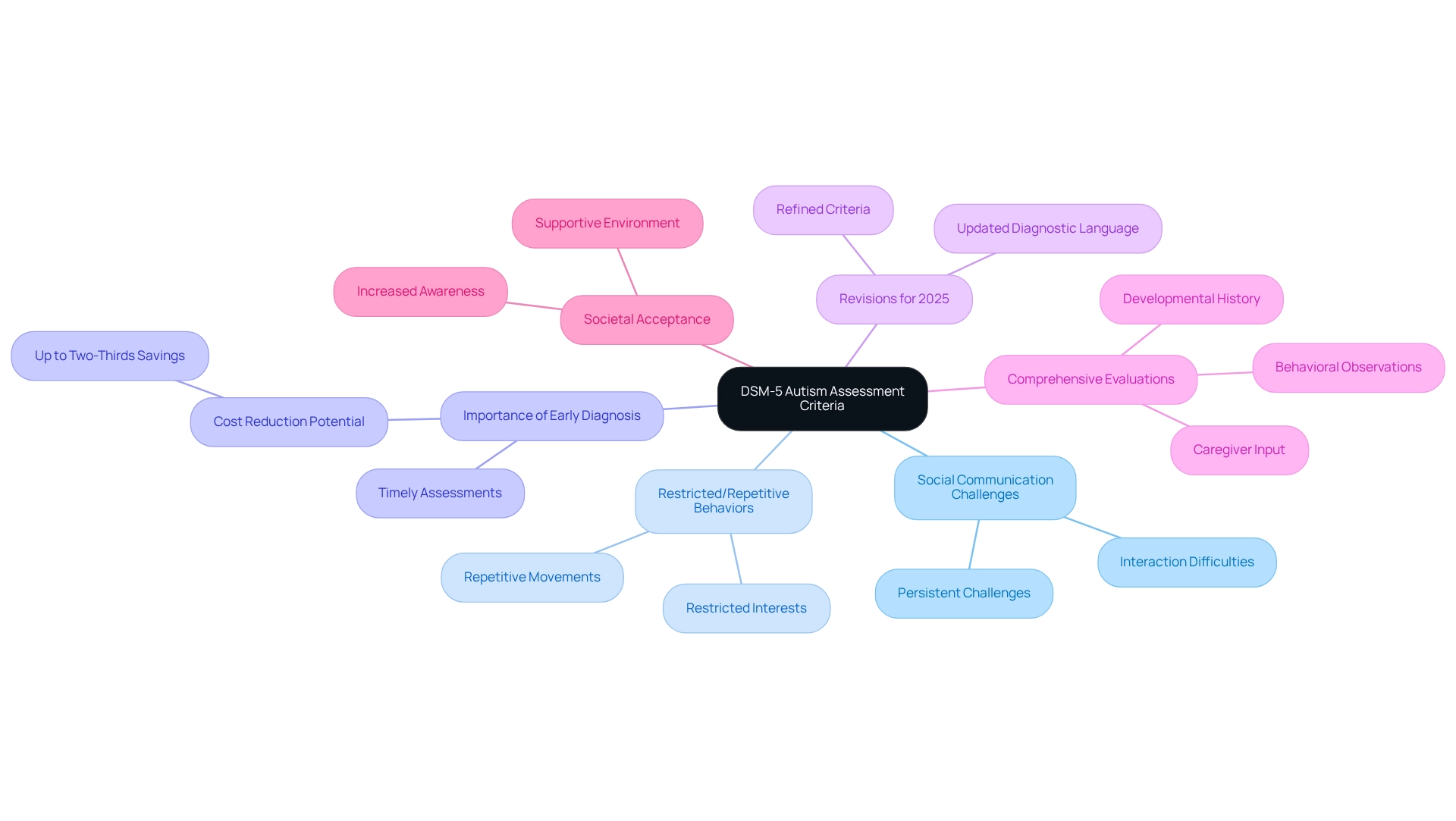
Early Diagnosis: Significance in Autism Support and Intervention
Prompt identification of the condition is vital, as it opens the door for timely support that significantly enhances social, communication, and behavioral abilities. It's heartening to know that studies show about 25% of youngsters diagnosed with the condition receive their diagnosis before the age of 2, often correlating with better long-term outcomes. Early assistance can lead to improved developmental trajectories; in fact, 91% of autism professionals advocate for person-centered approaches as the most effective methods in supporting autistic individuals. These approaches are particularly beneficial when implemented early, as they are tailored to meet the unique needs of children diagnosed at a young age.
Moreover, successful early intervention programs have shown that proactive engagement can lead to substantial improvements in quality of life. A compelling case study highlights an autistic adult who credits their positive life experiences to the unwavering support of family, friends, and therapy, illustrating how early assistance played a crucial role in their success. As Temple Grandin poignantly stated, 'Autism provides a special opportunity to see things in new ways,' emphasizing the unique perspectives that can emerge from early support. Thus, it is essential for parents to seek assessments promptly using the DSM-5 autism checklist when concerns arise, ensuring their children receive the vital resources and assistance needed to thrive. Additionally, parent training equips caregivers to manage challenging behaviors effectively, further strengthening the support network for their children. This journey, while challenging, can lead to remarkable growth and understanding for both parents and their children.
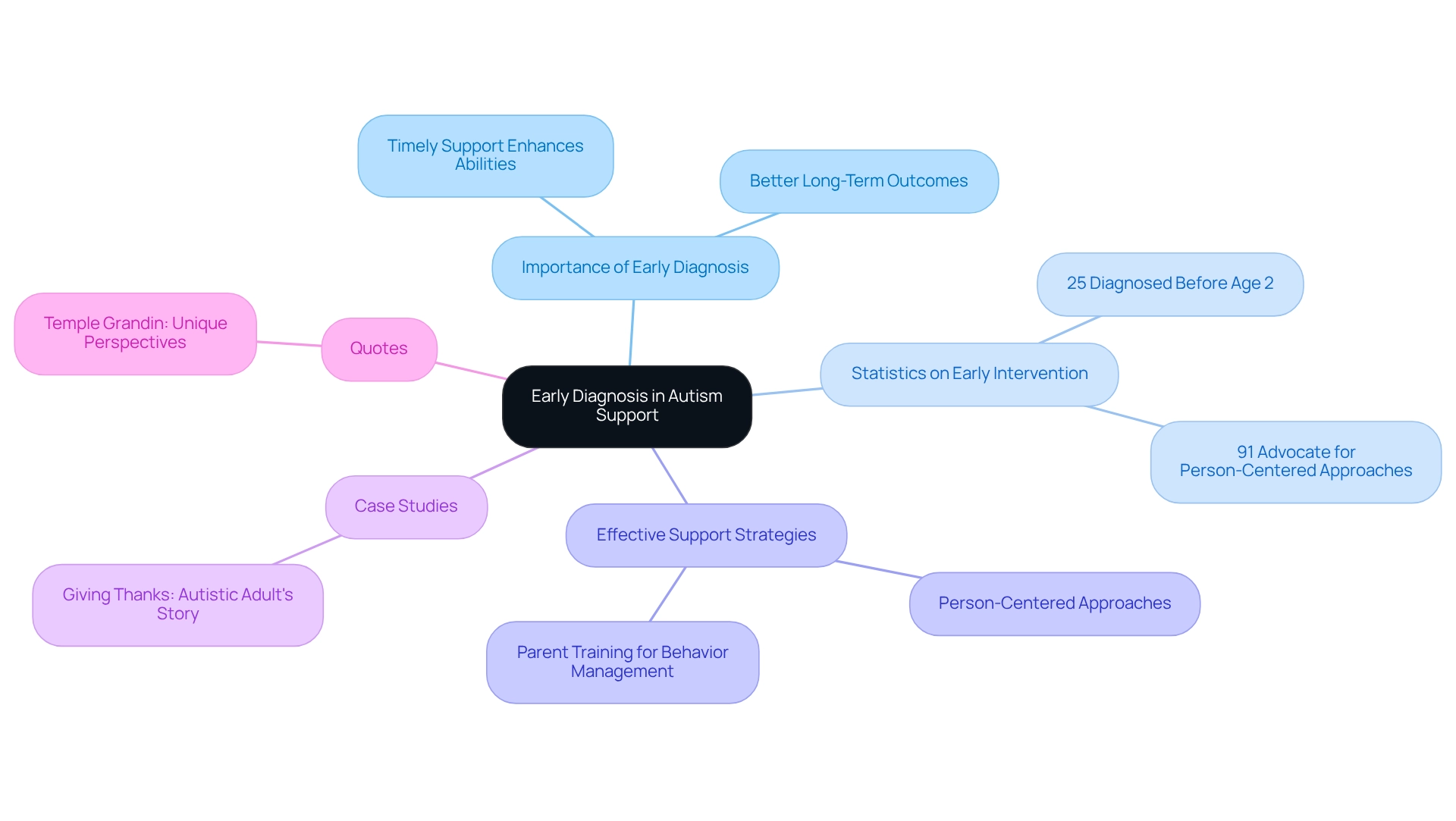
ASD Severity Levels: Understanding Different Autism Presentations
Understanding the severity of autism is vital for parents and caregivers. The DSM-5 categorizes the condition into three unique levels:
- Level 1, which requires assistance
- Level 2, which necessitates considerable assistance
- Level 3, which demands extensive assistance
These levels are essential as they indicate the degree of support individuals need to navigate daily life effectively.
For instance, a child at Level 2 may struggle with social interactions, requiring help in starting conversations. In contrast, a child at Level 3 might need ongoing assistance for daily activities. By recognizing the specific needs linked to each level, caregivers can implement effective strategies to enhance social skills development, manage challenging behaviors, and access appropriate resources.
Furthermore, organizations like ASD Media collaborate with allies such as CCN, ADASS, and CIPFA to improve intervention strategies and provide extensive support to families. Parents can leverage their understanding of these severity levels to seek specific resources or support groups tailored to their child's needs, ensuring they receive the appropriate assistance. Your journey as a caregiver is important, and finding the right support can make a significant difference.
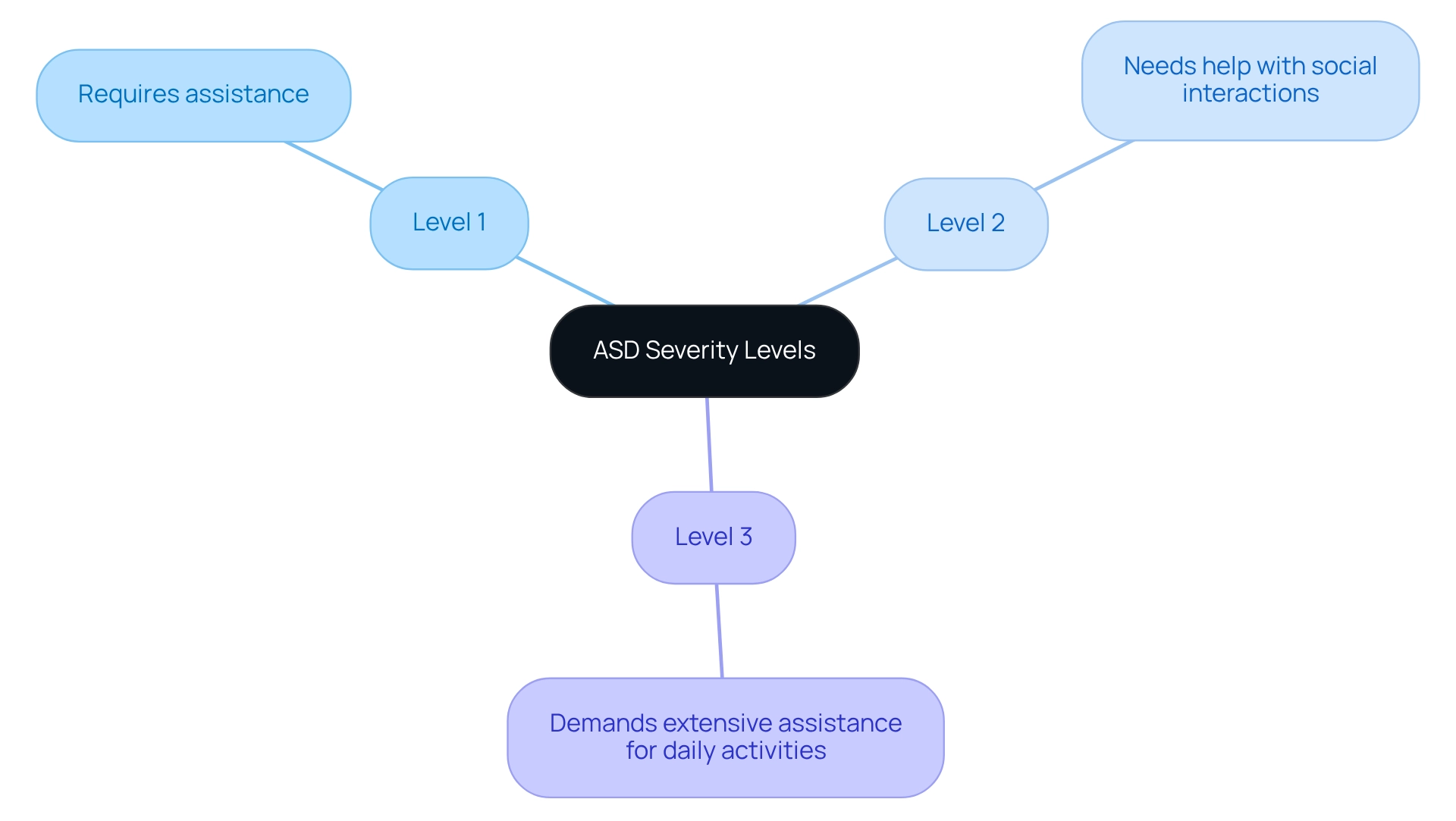
Common Autism Symptoms: Recognizing Early Signs for Better Outcomes
Navigating the world of autism can be challenging for families, and utilizing the DSM-5 autism checklist to understand the common symptoms is a vital first step. Difficulties in social interactions, communication challenges, and restricted or repetitive behaviors often characterize autism. Early signs may manifest as limited eye contact, a lack of response to one's name, or atypical play patterns. It's heartening to note that recent statistics indicate around 50% of parents are now recognizing these early signs, which is crucial for timely assessments and interventions.
Research reveals that individuals on the autism spectrum face a heightened risk of bullying and comorbid conditions such as anxiety and ADHD. This underscores the urgent need for comprehensive support systems that address these challenges. A poignant case study, 'Conditions and Risks Associated with Autism,' illustrates the diverse hurdles faced by autistic individuals and their families, highlighting the importance of the DSM-5 autism checklist for recognizing symptoms, enabling parents to facilitate early intervention that has been shown to lead to more positive outcomes for individuals with autism. Pediatricians emphasize that promptly identifying these signs can significantly enhance the quality of life for affected children and their families. Furthermore, a recent CDC study indicates that the prevalence of ASD is notably higher among Hispanic and non-Hispanic Black children compared to their non-Hispanic White counterparts. This highlights the critical importance of awareness and early detection across all demographics.
As we reflect on these insights, let’s remember that every small step we take can make a significant difference. If you notice any of these signs in your child, consider reaching out to a healthcare professional for guidance and support. Together, we can foster an environment where every child receives the understanding and care they deserve.
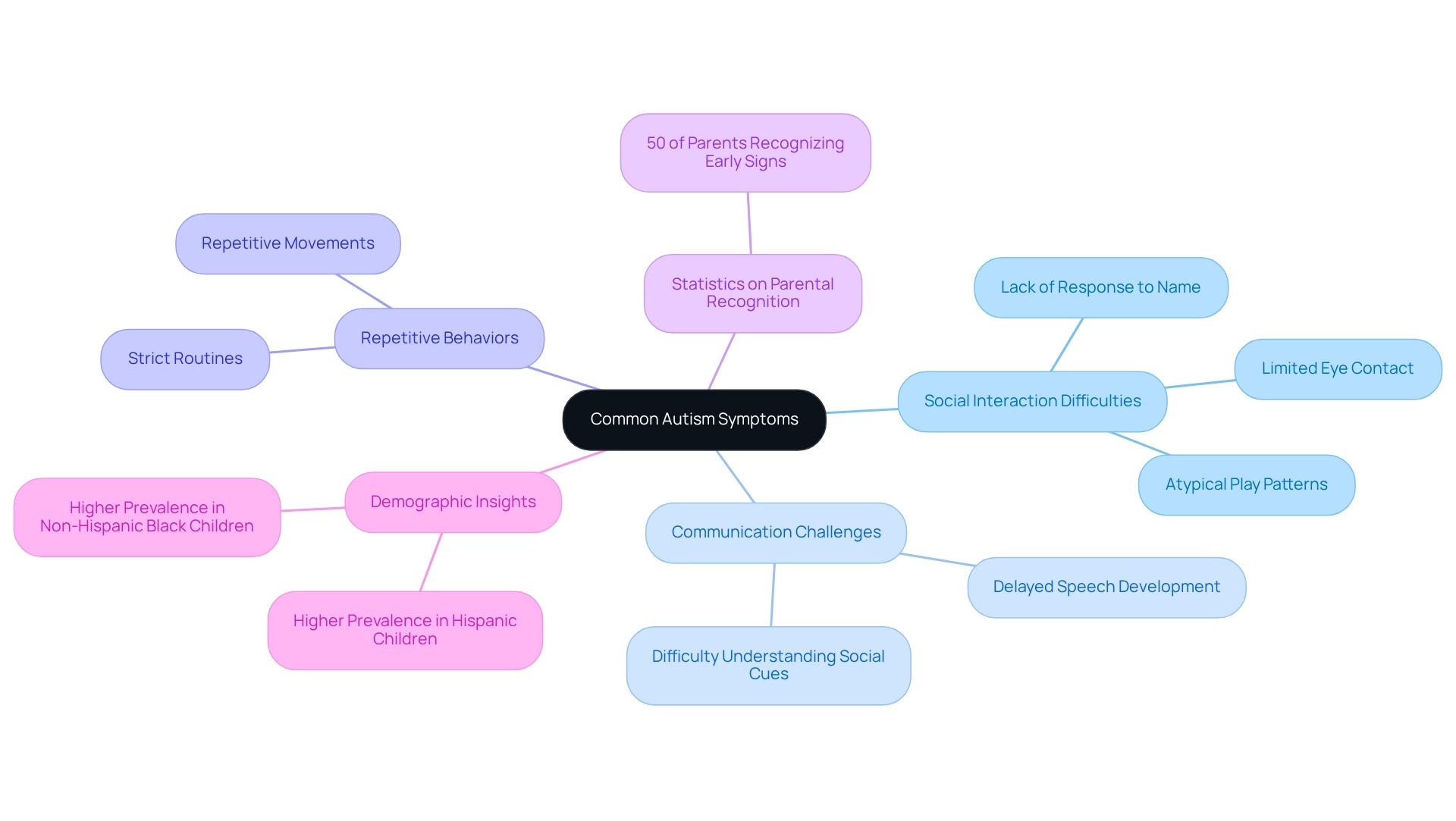
Diagnostic Tools: Essential Instruments for Autism Evaluation
A variety of diagnostic instruments play a crucial role in assessing conditions on the autism spectrum, with the Autism Diagnostic Observation Schedule (ADOS) and the Autism Diagnostic Interview-Revised (ADI-R) being among the most notable. These tools are designed to assist clinicians in evaluating social communication skills and repetitive behaviors, offering a structured framework for diagnosis. Notably, the ADI-R, particularly in its toddler version, demonstrates remarkable sensitivity ranging from 0.89 to 0.97 and specificity between 0.86 and 0.89, highlighting its reliability in identifying autism spectrum disorder (ASD).
In recent times, advancements have introduced remote assessment tools, such as the Systematic Observation of Red Flags of ASD, which aim to tackle the long waiting times often associated with diagnosis. These tools are being integrated into standard practice, signaling a shift towards more accessible assessments through telehealth platforms. This transition is essential for families who often feel overwhelmed and isolated while seeking information and support.
The effectiveness of the ADOS and ADI-R in diagnosing the condition is underscored by their widespread use and the positive feedback from clinicians. Experts stress that an accurate diagnosis is vital for effective treatment and support, as it lays the groundwork for tailored therapeutic interventions. With therapeutic behavioral services averaging $175.44, the importance of timely and precise evaluations cannot be overstated, especially considering the financial implications for families. As the CDC's ADDM Network continues to monitor ASD data across various U.S. locations, the ongoing enhancement of diagnostic tools is crucial for improving outcomes for individuals with the condition.

Changes in DSM-5: Evolution of Autism Diagnostic Criteria
The DSM-5 signifies a pivotal shift in how we understand and diagnose developmental spectrum conditions, merging previously distinct categories into one comprehensive diagnosis known as Autism Spectrum Disorder (ASD). This transformation reflects an evolving understanding of the condition, aiming to enhance diagnostic accuracy and consistency across various clinical environments. As we navigate this landscape, experts emphasize the importance of ongoing evaluation of diagnostic criteria. Recent research indicates that 81% of youth now meet ASD criteria, a notable increase compared to clinic-based studies that reported rates between 46% and 93%. This shift in diagnostic criteria has ignited discussions among researchers regarding its impact on the accuracy of autism diagnoses and prevalence rates.
Importantly, there is a pressing need for more community-focused research to validate these findings, ensuring that youth receive the essential support and services they deserve. As Matthew J. Maenner, PhD, from the CDC observes, 'Continually increasing awareness of ASD—leading to more detailed descriptions of behaviors in evaluations—could potentially explain why the ADDM Network ASD case children in 2008 were more likely to meet criteria than in 2006.' This insight underscores the importance of adapting to these changes, allowing us to better assist individuals on the spectrum.
As we reflect on these developments, let us remain committed to understanding and supporting those affected by ASD, fostering an environment where every individual can thrive.
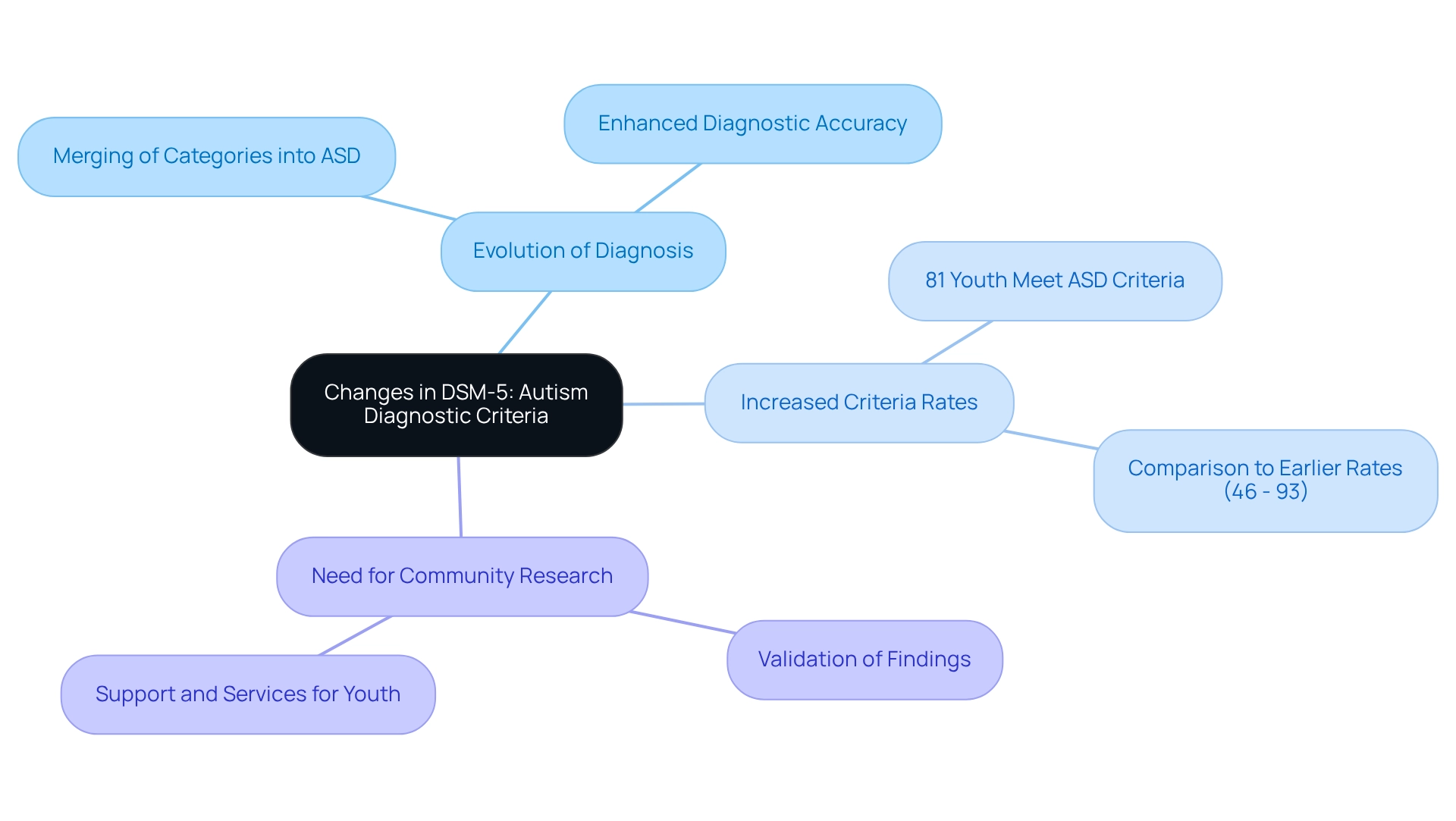
Social Communication Deficits: Impact on Autism Diagnosis
Social communication deficits are at the heart of this condition, presenting challenges in both verbal and nonverbal communication. These difficulties can significantly impact an individual's ability to engage in social interactions, highlighting the critical need for clinicians to carefully assess these skills during evaluations. Early recognition of these deficits is vital, as tailored support can greatly improve social outcomes for young individuals with developmental disorders. For example, research shows that children who receive early intervention often exhibit improved social skills and overall well-being, as demonstrated in the case study 'The Importance of Early Intervention in Autism.'
Experts stress the significance of evaluating communication skills as part of the DSM 5 autism checklist in autism assessments. Clinicians argue that while standardized evaluations can provide valuable insights into a young person's performance, they often overlook the nuances of real-life communication challenges. As Diehl points out, "Although standardized assessments are typically helpful in determining present levels of performance, they often result in a deficits profile that does not translate well to interventions that are family-centered and focused on real-life activities." This perspective underscores the need for a more personalized approach that considers the unique social communication profiles of each child.
As we look ahead to 2025, the emphasis on social communication deficits remains crucial, with ongoing discussions among professionals about best practices for assessment. Case studies indicate that children with significant social communication deficits frequently encounter difficulties in initiating conversations and interpreting social cues, leading to feelings of isolation and frustration. By prioritizing the DSM 5 autism checklist evaluations, healthcare professionals can better support families in navigating the complexities of diagnosis and treatment.
Moreover, technology is increasingly acknowledged as a helpful resource for enhancing social and communication skills through interactive programs and tools. Incorporating social communication abilities into the diagnostic process not only refines the accuracy of diagnoses related to developmental disorders but also lays the groundwork for effective, family-focused interventions that promote meaningful social interaction.
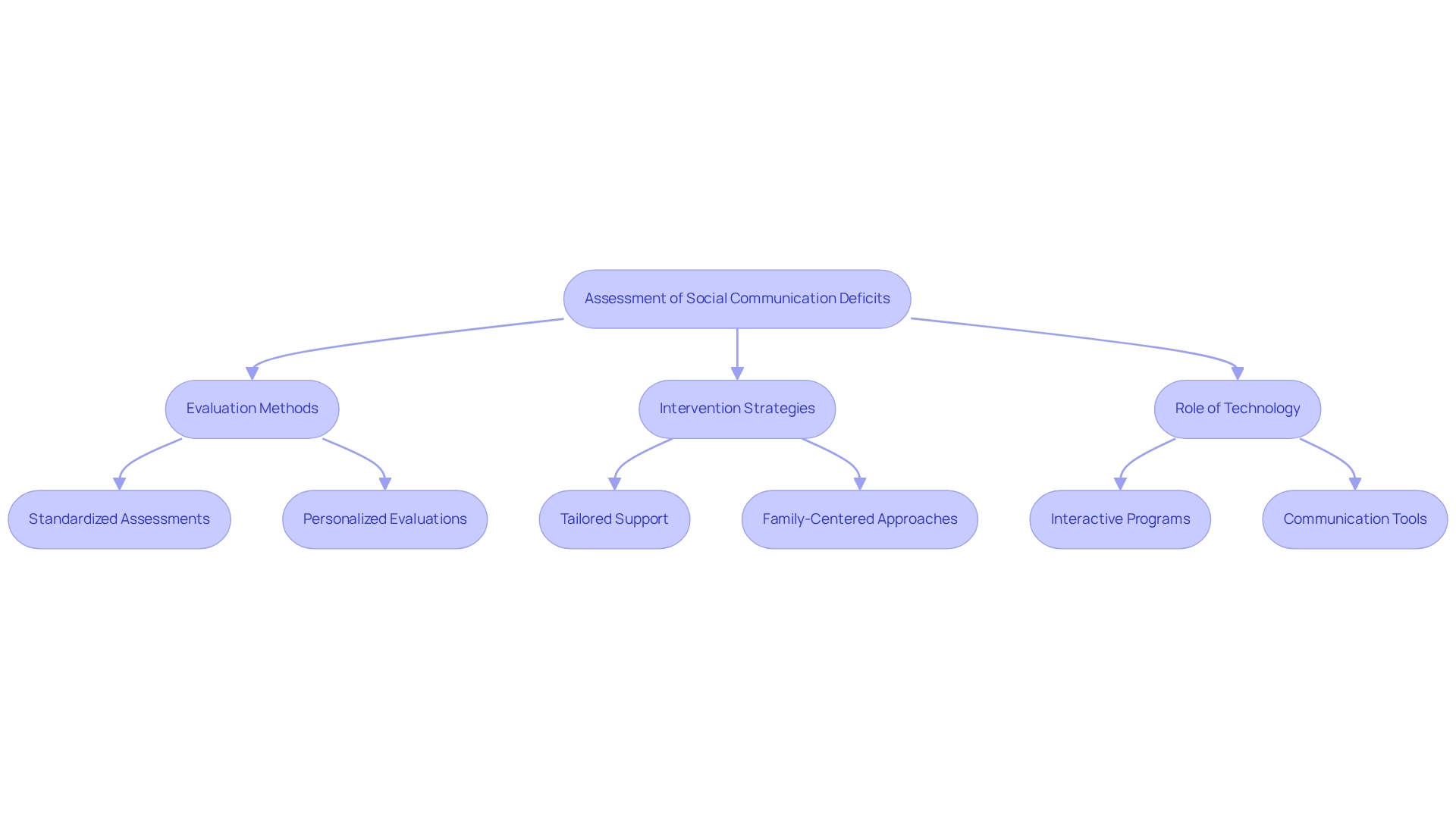
Restricted and Repetitive Behaviors: Key Indicators of Autism
Restricted and repetitive behaviors (RRBs), such as hand-flapping, organizing toys, and insistence on sameness, are essential indicators of the autism spectrum. These behaviors not only reflect an individual's coping mechanisms but also offer valuable insights into their preferences and emotional states. Research shows that around 70% of individuals with autism exhibit some form of RRBs, underscoring their significance in the diagnostic process.
Recognizing these behaviors is crucial for a broader assessment strategy. Isabel Ricke emphasizes that community partners at clinical and educational data sources have shared information that enabled the generation of accurate estimates of ASD prevalence. This collaborative approach has led to a more precise understanding of RRB prevalence and characteristics, highlighting the need for tailored treatment strategies that effectively address these behaviors.
Consider how clinicians utilize RRBs in diagnosis. For example, a young child who consistently arranges toys in a specific order may be demonstrating a need for predictability, serving as a key behavioral indicator. Understanding these behaviors allows professionals to develop targeted interventions that cater to each child's unique needs.
As we move toward 2025, the emphasis on RRBs remains dynamic, with ongoing research investigating their effects on treatment and their significance in the broader context of developmental disorders. The insights gained from these studies reinforce the notion that addressing RRBs can significantly enhance outcomes for individuals on the autism spectrum. By acknowledging and comprehending these behaviors, parents and professionals can work together to develop effective strategies that improve the quality of life for children with developmental disorders.
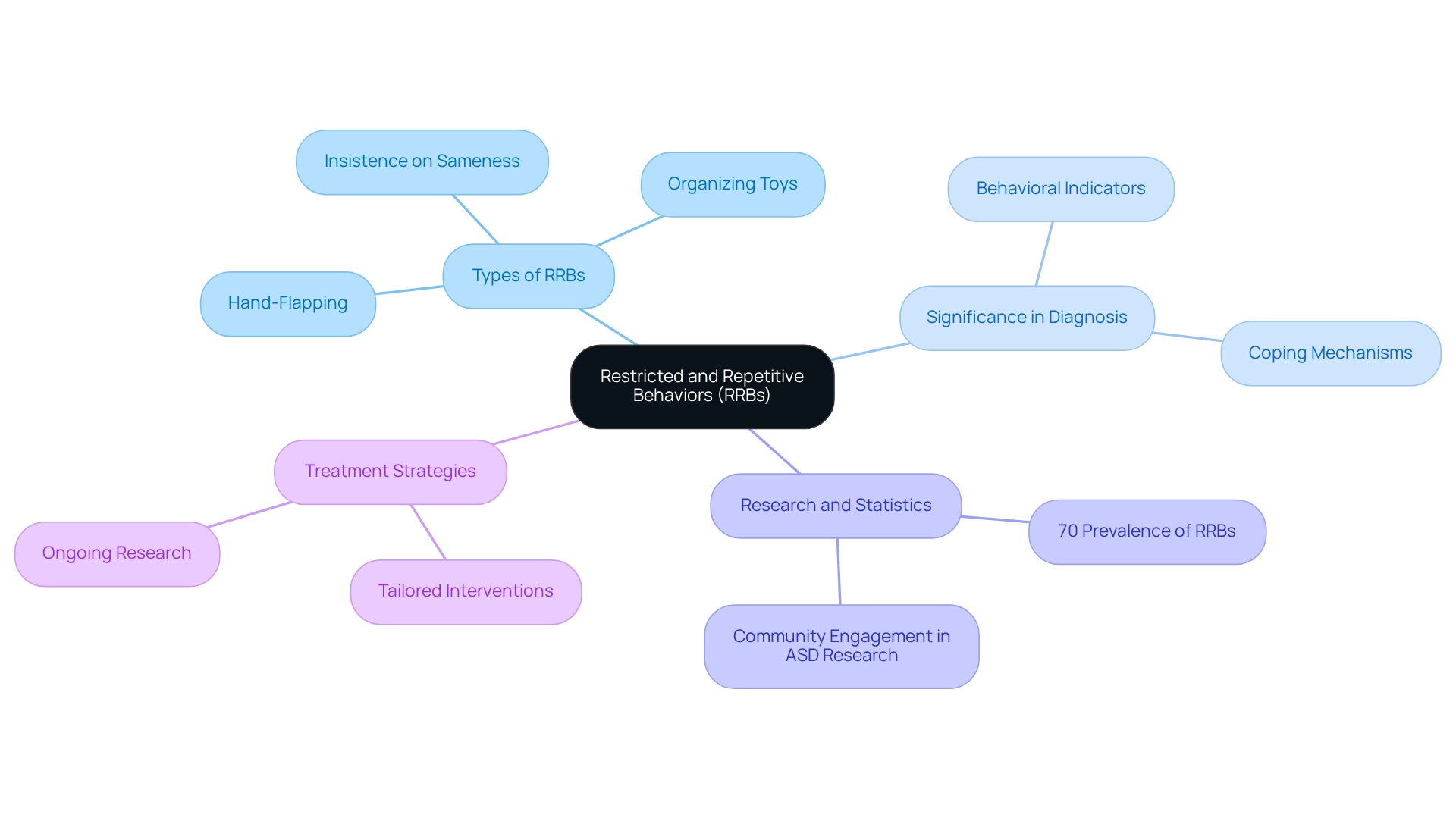
Ongoing Assessment Resources: Ensuring Continuous Support for Autism
Continuous evaluation resources, including regular check-ins with healthcare providers and the DSM-5 autism checklist for updated screening tools, play a vital role in ensuring that individuals on the spectrum receive the support they need throughout their development. These resources help track progress and adapt interventions to meet evolving challenges, ultimately improving the quality of care. Statistics reveal that most children receive a diagnosis after age four, despite the fact that the condition can be reliably identified as early as age two. This underscores the importance of early and ongoing evaluation in providing timely assistance.
Moreover, successful models for ongoing support in developmental disorder care highlight the necessity of regular evaluations to effectively adjust therapeutic strategies. Clinicians emphasize that ongoing assessments are essential for nurturing an environment of empathy and understanding, which is crucial for advocating for neurodiversity. As Harvey Blume wisely noted, 'Neurodiversity may be every bit as crucial for the human race as biodiversity is for life in general.' Incorporating perspectives from individuals with developmental differences and their families into research further enriches these evaluation tools, ensuring they remain relevant and effective.
Additionally, it is important to recognize that 5% of all students in the U.S. do not complete high school, illustrating the long-term impact of early and ongoing evaluation on educational outcomes for individuals with developmental disorders. By prioritizing continuous evaluations with the DSM-5 autism checklist, parents and experts can significantly improve outcomes for children with developmental disorders, fostering a more supportive and inclusive community. Furthermore, the average cost of therapeutic behavioral services, which stands at $175.44, should be considered when evaluating ongoing support options. The case study titled 'The Power of Kindness' serves as a poignant reminder of the importance of empathy in advocating for neurodiversity and acceptance of autistic individuals. By weaving these elements together, we can better appreciate the critical role of ongoing assessments, including the DSM-5 autism checklist, in supporting those on the autism spectrum.
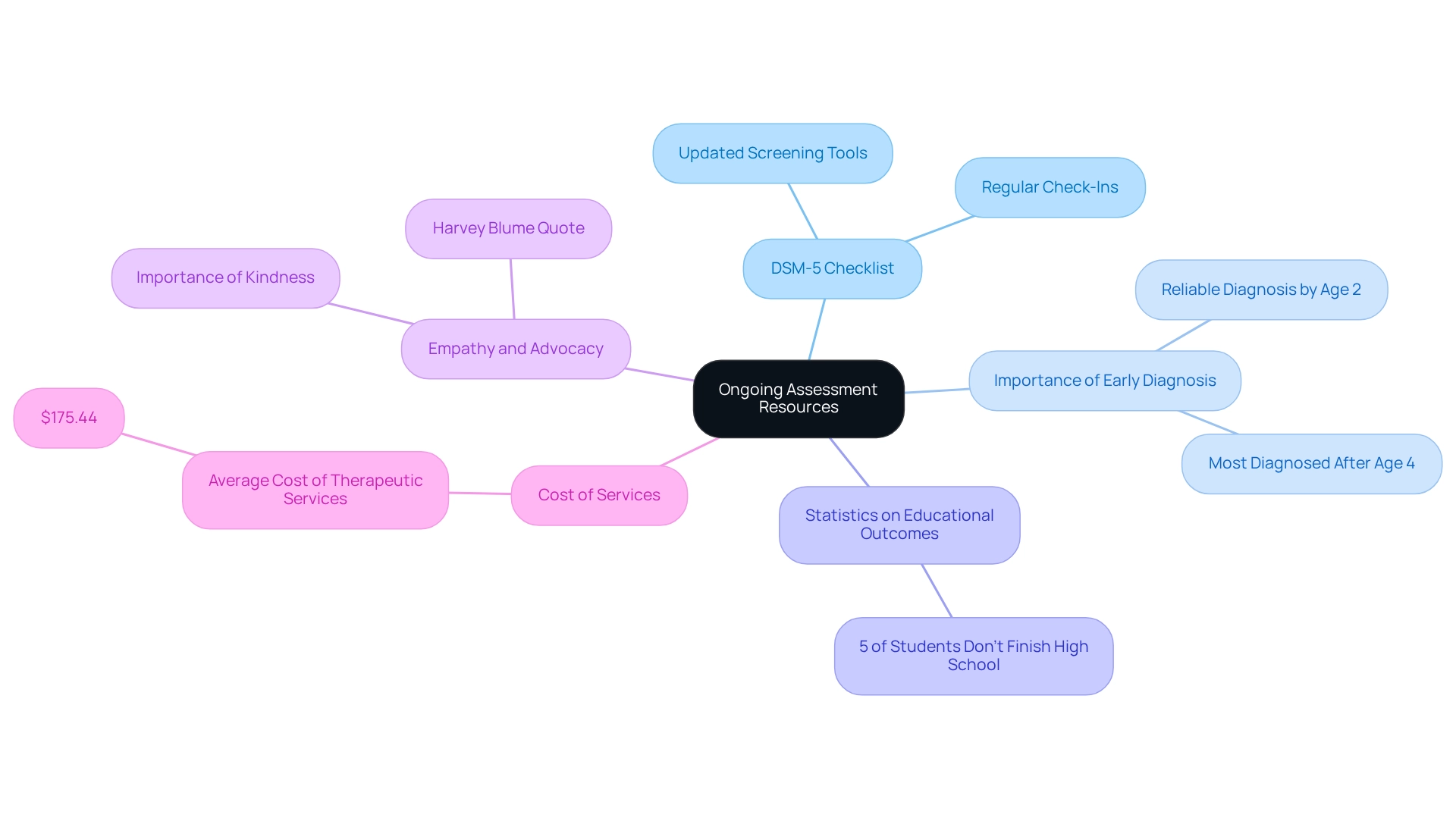
Conclusion
Understanding and supporting individuals with autism is a multifaceted endeavor that requires a heartfelt commitment to early diagnosis, tailored interventions, and ongoing assessment. It’s crucial to recognize the unique needs associated with different severity levels of autism. Organizations like ASD Media play a vital role in providing resources and fostering community support. Early intervention remains a cornerstone of effective autism support, with research showing that timely evaluations can lead to significantly improved outcomes for children.
The integration of advanced diagnostic tools and the evolution of the DSM-5 criteria have greatly enhanced the accuracy of autism assessments. This allows clinicians to develop personalized intervention strategies that truly cater to individual needs. Moreover, emphasizing social communication deficits and restricted behaviors highlights the importance of understanding each person's profile to inform treatment approaches. Continuous assessment not only tracks progress but also adapts support strategies to meet the evolving needs of individuals with autism throughout their lives.
In conclusion, a collaborative approach involving families, professionals, and supportive organizations is essential for creating a nurturing environment for those on the autism spectrum. By prioritizing early diagnosis, leveraging effective assessment tools, and fostering community connections, we can pave the way for a brighter future for individuals with autism. As awareness and understanding continue to grow, so too does the potential for meaningful change that enhances the quality of life for individuals with autism and their families. Let’s work together to make a difference.
Frequently Asked Questions
What is the mission of ASD Media regarding Applied Behavior Analysis (ABA) therapy?
ASD Media is committed to advancing the implementation of ABA therapy by providing insights and strategies to improve outcomes for children with developmental disorders and ADHD, while also offering resources for parents and professionals.
How prevalent are developmental disorders among boys compared to girls?
As of 2025, boys are diagnosed with developmental disorders 3.4 times more frequently than girls, indicating a significant need for focused assistance.
What percentage of caregivers utilize ABA therapy for individuals with developmental disorders?
Recent statistics show that 36.5% of caregivers for individuals with developmental disorders utilize ABA therapy, with many reporting positive outcomes.
What is the graduation rate for autistic students from high school?
Approximately 73.6% of autistic students graduate high school, although tailored approaches like Individualized Education Programs (IEPs) are essential for those facing educational challenges.
Who can families turn to for understanding developmental disorders and exploring treatment options?
Families can seek help from Board-Certified Behavior Analysts (BCBAs) at Prospera Healthcare, who are dedicated to helping them understand developmental disorders and effective treatment options.
What role does community support play in the success of ABA therapy?
Community assistance is vital in achieving successful therapy results, as it fosters collaboration and shared experiences that enhance the effectiveness of support services.
How does early diagnosis and intervention impact healthcare costs?
Early diagnosis and intervention can significantly lower healthcare costs, potentially reducing them by up to two-thirds, highlighting the importance of timely assessments.
What tool is widely regarded for evaluating developmental disorders?
The DSM-5 autism checklist is recognized as an invaluable tool for clinicians, providing a structured framework that enhances diagnostic accuracy and consistency.
What recent changes are expected in the DSM-5 autism checklist criteria?
Revisions to the DSM-5 autism checklist criteria are anticipated to reflect a growing understanding of developmental disorders, ensuring evaluations remain relevant and effective.
What percentage of autism professionals advocate for person-centered approaches in support?
About 91% of autism professionals advocate for person-centered approaches as the most effective methods in supporting autistic individuals, especially when implemented early.
How important is early intervention for children diagnosed with autism?
Successful early intervention programs can lead to substantial improvements in quality of life, and studies show that children receiving early assistance often have better long-term outcomes.
What resources can parents access to support their children with autism?
Parents can access vital resources and assistance through assessments using the DSM-5 autism checklist, as well as training programs that equip caregivers to manage challenging behaviors effectively.




